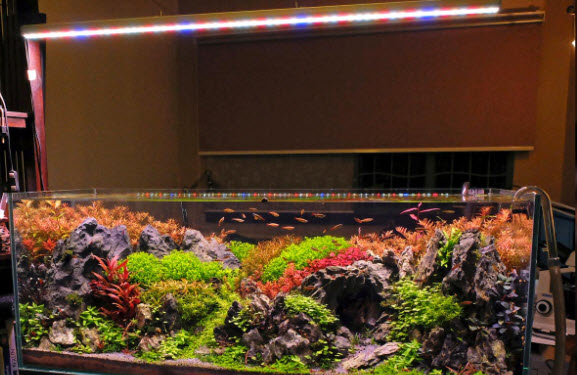
Lighting is essential for the aquarium. It is an integral part of enjoying the aquarium. But lighting has become a very complex issue. The number of options has become huge. The old fluorescent tube aquarium fixtures have become a thing of the past. The new LED fixtures have taken over. Each of these fixtures has 20 to 100 small (typically 3 watt) LED lights in a multitude of colors.
The simplest and cheapest LED lights are “all white” LEDs. These “all white” LEDs have some significant shortcomings. They do not have the blue and the crimson red colors needed for good plant growth and good color on some fish.
One must look at the spectrum of LED lights to get the best. To get the best combination of fish color and plant growth one needs three types of LEDs in combination: daylight (most cheap LEDs), crimson red and blue (“grow lights”). If you only use the cheap shop LEDs for instance, your plants will not thrive and your electric blue Fryeri and your red dragon blood peacock will not have good color. Use only grow lights (crimson red and blue) and everything in the tank will be purple and your yellow Lab will have no color.
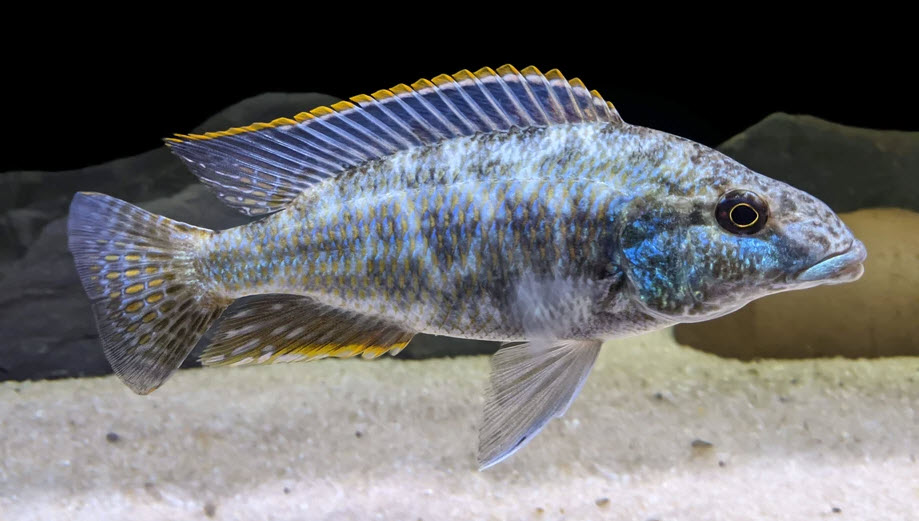
An aquarium LED with 15 to 25% red LEDs and 15 to 25% blue LEDs will cover the full spectrum and duplicate sunlight. This will give the best plant growth and the best fish colors. Combining a shop LED with a smaller violet grow light LED set also works great.
Note that a high tech planted tank with very high lighting needs crimson, blue AND WHITE light. Only blue and crimson light is not optimum in high light conditions. Recent research has shown that the pigments which absorb green light (red and orange pigments) function to protect chloroplasts at high light intensities and give energy to the chloroplasts that they can use.
Then there are some non-programmable aquarium LED lights which have roughly 80% white LEDS, 10% blue LEDS and 10% red-pink LEDS. These are a very good option for the aquarium.
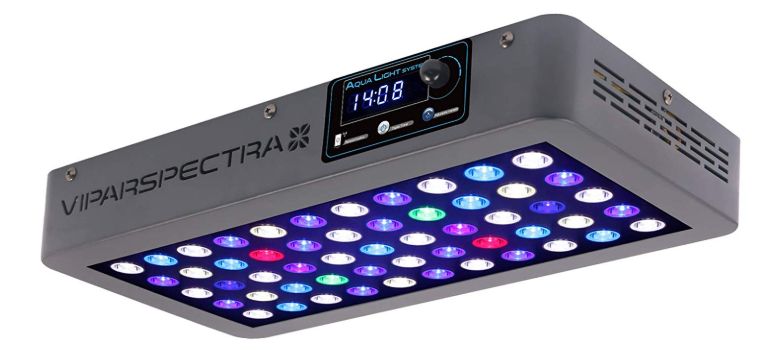
The most advanced (and most expensive) LED lights are computerized with four programable timed light channels that can vary the amount of white, blue, green or red-light present over time with remote controls or even WIFI cell phone controls.
One can program in a blue-red combo for when the owner isn’t around to maximize plant growth. Then a normal spectrum can be programmed in for when the owner is there since the normal spectrum is more pleasing to the eye. Gradual increases and decreases in light can also be programmed in to duplicate dawn and sunset.
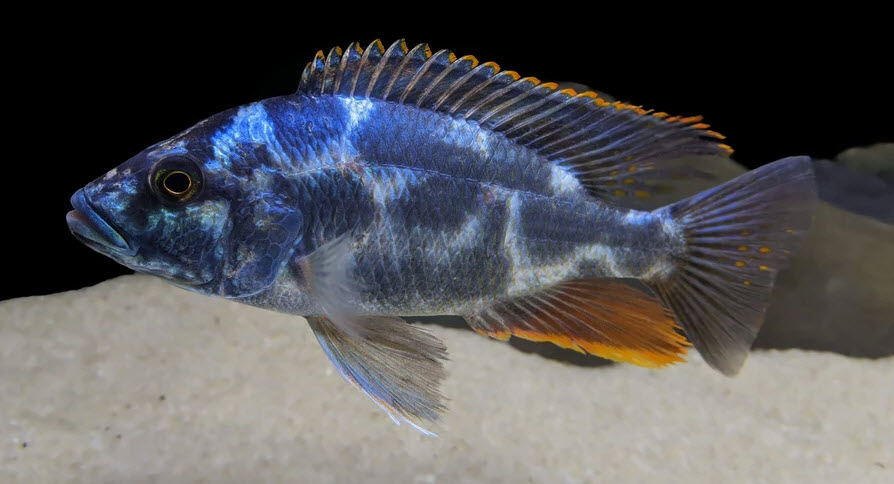
It is important with LED lights to isolate the lights well from the moisture inherent in most aquariums, especially spray from an air stone. When the bubbles of an air stone break the water’s surface, they form what is known as an aerosol of fine water droplets which drift upward into the circuitry of the LED lights. This corrodes and shorts out the lights in short order.
Suspending the LED lights more than four inches above the aquarium can lessen the problems with circuits shorting out. An airflow through the LEDs is also useful in preventing moisture problems. A computer fan can be used to create an airflow across the LED lights with a very low noise level.
The “strength” of a given LED light is best looked at from the standard of actual watts multiplied by eight. If an LED grow light has an actual wattage of 13.5 watts, then its relative strength is 8 x 13.5 = 108 equivalent watts.
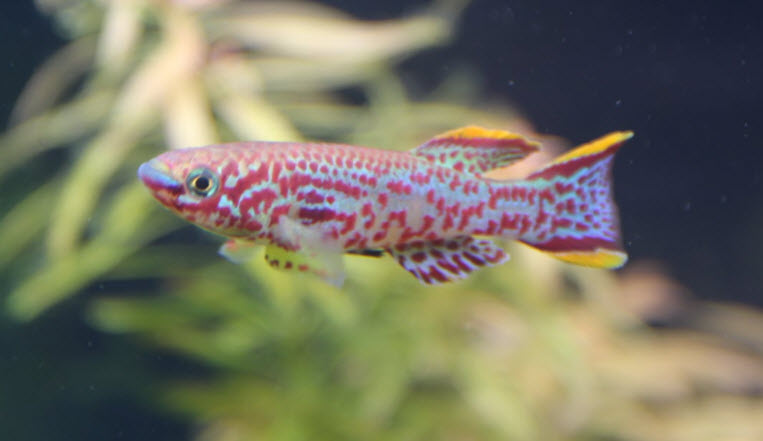
Obsolete Light Standards
With the advent of LEDs, some of the old standards have become largely obsolete. The standards include lumens, PAR and degrees Kelvin. More about obsolete light standards in this link:
14.4.2. Obsolete Light Standards
.
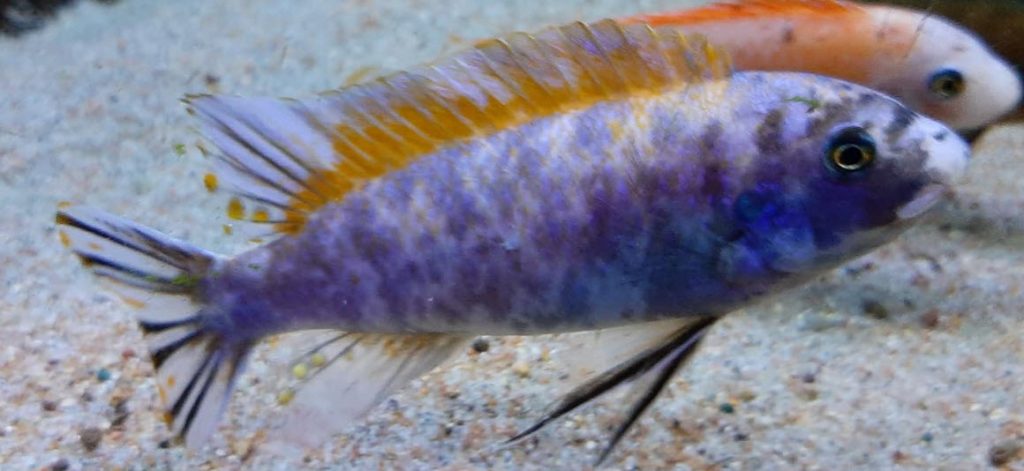
More about the important spectrum of lights in the following Pages:
14.4.1. The Spectrum of Lights
.
Return to Equipment Menu
.
Aquarium Science Website
The chapters shown below or on the right side in maroon lead to close to 400 articles on all aspects of keeping a freshwater aquarium. These articles have NO links to profit making sites and are thus unbiased in their recommendations, unlike all the for-profit sites you will find with Google. Bookmark and browse!
.

John Perdue says
You’ve been the greatest source of information to me. I can’t thank you enough for this blog.
The main thing is that no other person or company (it seems) will commit to the ideal of a truly scientific approach. And, again I just cannot thank you enough for that.
Mainly I just want to have a nice, hopefully beautiful, aquarium – of course.
So… I’m guessing you are not having any questions about the lighting of you own tanks..? And, that is why this section has not been revisited?
I DK… except that for awhile now I’ve been reading about green light being beneficial and blue light not so much. (see below)
My main question for the scientific community is: Why in 3.4 Billion years have plants not been able to evolve to take advantage of the entire spectrum available to them? I more than concede there may be some reason of physics which I’ve yet to comprehend that limits photosynthetic organisms from exploiting the entire spectrum of available light. Just please, sincerely, can it be explained, what is it?
https://academic.oup.com/jxb/article/68/9/2099/3857754
https://www.canr.msu.edu/news/green_light_is_it_important_for_plant_growth
https://en.wikipedia.org/wiki/Evolution_of_photosynthesis
Dave says
I doubt if there is a minimum but I’ve never seen any research on it so I can’t say for sure.
Alex says
Hi! As always thank you so much for such amazing info on your website my aquarium is flourishing. I actually have a strange problem of no algae at all in my aquarium, I think through really good filtration and lots of plecos. The plants weren’t doing too well so I’ve increased light and nutrients and I’m running the nitrate around 40 and using tropica specialised nutrition and will start homemade plant tabs also soon. I have a juwel 450 with its own light system. I’m running lights 17h on and 7h off. My question is can you have too many hours of light and does this upset the fish? What’s the minimum hours of no light the fish need in 24h?
Many thanks!
Dave says
In reply to Mason ……. IR and UVB/UVA are important for some reptiles. I’m not aware of any research saying they are in any way important for water plants, terrestrial plants and/or fish. Note one has to be very cautious here in that some suppliers of things such as UV lamps have put out some “research” which is bogus. The good old “profit motive” strikes again.
Mason Shelnutt says
Towards the beginning of this section on lighting, you state that “An aquarium LED with 15 to 25% red LEDs and 15 to 25% blue LEDs will cover the full spectrum and duplicate sunlight”. My understanding is that conventional aquarium LEDs *do not* include some important spectral components of
actual sunlight, such as IR or UVB/UVA (unlike some “older” lighting technologies such as MH lamps or tubular lamps, which can include a technically more comprehensive spectrum w/ regard to simulating natural sunlight). While I’m not as learned about the possible effects of these spectrum on fish or corals, I have followed some research showing that these spectrum are in some varying degrees important to reptiles, amphibians, and terrestrial plants. I suppose I am making this comment to seek clarification on your meaning behind the quotation from your article that I provided above, since I find most of the other information throughout your website to be very helpful/informative to the aquarium hobby (which may also draw the attention of some keepers of aquatic reptiles and amphibians). And I’ll also take this opportunity to thank you for this immense resource you’ve put together 🙂